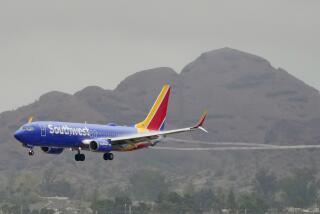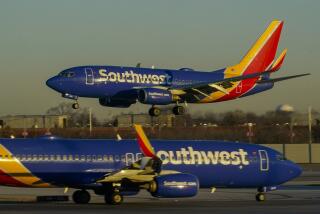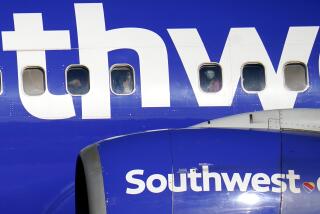TRAVEL INSIDER : Winners and Losers in Airlinesâ Class Warfare : Competition: Carriers are rearranging seats to attract different mixes of customers. Result: Some travelers suddenly get more legroom, others take it on the shin.
Attention, airline passengers. The subject is seat class and legroom, and we seem to have a bit of turbulence ahead.
We take you now to reader Mary Barlow of Orange County, who recently traveled to London via Virgin Atlantic Airways. Soon after settling into her economy-class seat, she sensed something amiss. Something . . . constricting. In order to accommodate their new Mid Class section, Barlow deduced, Virgin Atlanticâs interior designers âtook out most of the legroom from economy!â
They took some, anyway. Virgin Atlantic spokeswoman Lori Levin acknowledged last week that cabin interiors were redesigned to make room for the airlineâs new Mid Class seats--and the relatively spacious 38 inches of legroom between them--when the section debuted in April. Levin also noted, however, that Virgin still gives its economy travelers as much or more room than many of its competitors do.
Now flash to Kim Prisk of San Diego, who recently found himself in the air between Newark, N.J., and Munich. There, Prisk discovered that Continental Airlines, too, was fiddling with its class system, to his advantage. Prisk was expecting a business-class seat with its usual 40-inch pitch--that is, 40 inches between his seat back and the seat in front of him. Instead, he found that the airline is in the middle of merging its first-class and business-class sections on international flights to form âBusinessFirstâ class, and is leaving 55 inches between seats in the new section. Prisk stretched, slept and reported that âit was delightful.â
The class system has been a complicated and competitive issue among air carriers for years, and it has been made more so by the burgeoning masses of frequent fliers seeking upgrades and the conflicting examples set by European carriers, whose service is so highly admired by American travelers. Beyond that, the U.S. carriers seem to have widely varied ideas of what the market wants. And so, boarding an American commercial jet these days, we canât be sure just how many compartments weâll see, how comfortable theyâll be or what theyâll cost.
Some airlines, such as Continental and USAir, are vying for business travelers who are no longer willing to pay for a first-class seat. âThere are a lot of companies that will spring for business class that wonât spring for first-class,â said Dave Shipley, assistant vice president for public relations at USAir. âAs long as you can sell your business seats, you really donât need a first-class.â
Other carriers are looking out for those travelers who go first-class regardless of the economy at large. Delta Airlines is nearly doubling the number of first-class seats on the 80 Boeing 737 jets it flies in North America, and an American Airlines spokesman recently underscored the carrierâs commitment to a three-class system on all transoceanic and some domestic flights.
At the same time, leading U.S.-based carriers have begun offering three levels of service, instead of two, on major business routes inside the United States, with United and American following TWAâs lead.
All this jostling draws scant attention from those travelers looking only for low prices, and itâs easy to see why. When I called American Airlines last week to ask for prices on a Jan. 13 flight from Los Angeles to London, the reservationist told me I could have a discounted, restricted coach round-trip ticket for as little as $498, an unrestricted coach ticket for $3,424, a business-class ticket for $5,236, or a first-class ticket for $8,100.
Comfort costs. Still, many frequent fliers, especially those traveling on business, highly prize the extra legroom, the priority service, the superior meals served on china, the seat-back video terminals and telephones, and the free drinks and newspapers that extra money buys. This monthâs Frequent Flyer magazine survey of its readers (median household income: $118,800) showed that 7% usually buy first-class tickets on international flights, and 39% usually buy business-class tickets.
Hereâs a quick look at 10 major U.S. carriers, their class systems and the amount of legroom they allow in their more costly classes. (Coach legroom is more or less constant, varying from 31 to 33 inches between seats.)
Travelers should remember that the numbers are averages, not absolutes, and that they were supplied by the airlines themselves. Also remember that service can matter just as much as legroom, but isnât as easily measured. Coach and economy classes are interchangeable. Those considering a high-priced ticket should also ask a lot of questions about exactly what a first-class fare includes that a business-class ticket doesnât. Sometimes, another 12 inches of legroom, the use of a personal videocassette player and a few other âfreebiesâ just donât seem worth an added $3,000.
Alaska. First and economy classes on flights to the United States, Mexico and the Far East. On most flights, first-class seat pitches average 37 inches. America West. About six weeks ago, America West abandoned its last business-class seat and became a two-class airline. First-class seats come with an average seat pitch of 36-38 inches.
American. On international flights and Los Angeles-New York and San Francisco-New York connections, first and business classes have average seat pitches of 52-53 inches and 40 inches, respectively. On most of its other domestic flights, the carrier offers first (53-54 inches between seats) and coach classes.
Continental. On most domestic flights, Continental offers first and coach classes, with first-class seat pitches averaging 36-38 inches. By the end of March, the airline will have dismantled its international first and business classes in favor of a new hybrid, BusinessFirst, with 55-inch seat pitches.
Delta. On domestic flights, Delta offers first and coach class with average first-class seat pitches of 37 inches. In its recent reconfiguration, first-class seating in Deltaâs 757 jets grew from 16 such seats to 26, while coach seating fell from 171 to 156.
On transoceanic flights and domestic connections leading to transoceanic flights, the airline offers first, business and coach classes. In L-1011 jets, commonly used on Deltaâs international routes, first-class seats have an average pitch of 60 inches; business, 40 inches.
Northwest. On most transoceanic flights, Northwest offers three classes, seats pitched at averages of 62 inches for first and 38-40 for business. On domestic flights and some routes between Europe and the East Coast or Midwest, Northwest offers two classes, with first-class seats pitched at an average 36-38 inches.
Southwest. Southwest remains removed from the class system fray, flying only domestically and assigning all passengers to a single âpleasure class,â with seat pitches averaging 31-33 inches.
TWA. On transoceanic flights and many long domestic flights, TWA uses wide-body jets that include economy, Ambassador (business) and first classes. Shorter domestic flights (Los Angeles-St. Louis, for instance) include first and economy only. Long-distance first-class seat pitches average 55-57 inches; Ambassador, 38 inches. On domestic flights with two classes of seating, pitch averages 37-38 inches in first.
United. Unitedâs domestic flights (usually on Boeing 737-300s) include first and economy classes. Jets are configured with seat pitches averaging 36-38 inches in first. International flights, and some domestic flights, add a Connoisseur class between first and economy. Seat pitches are 54-60 inches in first, 40 in Connoisseur.
USAir. On domestic flights, USAir offers first and coach, with average first-class seat pitches of 36-39 inches. On transoceanic flights, the carrier offers business (average pitch: 38 inches) and coach. New first-class and business-class seat installations are expected next year.
Virgin Atlantic, the carrier that disappointed Mary Barlow, isnât based in the United States. But it seems only fair to sketch that 8-year-old, England-based airlineâs approach to classes. Virgin allows its Upper Class travelers an average seat pitch of 55 inches, along with such perks as limousine service, seat-back video units and, occasionally, manicures, for prices comparable with other carriersâ business-class fares. Virginâs Mid Class travelers, who buy unrestricted, full-fare Economy tickets, get 38 inches of seat pitch. Consumer Reports Travel Newsletter named Virgin the best international airline of 1992.
More to Read
Sign up for The Wild
Weâll help you find the best places to hike, bike and run, as well as the perfect silent spots for meditation and yoga.
You may occasionally receive promotional content from the Los Angeles Times.







